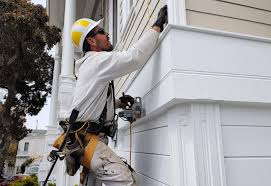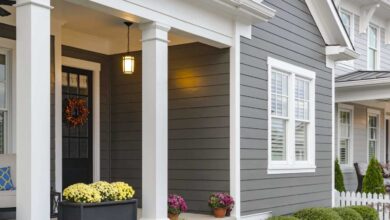The Importance of Siding in Construction
Siding in Construction – The siding of a building is not only crucial for protecting its structural integrity but also plays a significant role in enhancing its aesthetic appeal. From weather resistance to insulation, siding materials serve various purposes that make them an indispensable component of any construction project. This blog article aims to provide a detailed and comprehensive guide to siding in construction, shedding light on its importance, types, installation process, maintenance, and more.
In this article, we will explore the different types of siding materials available, such as vinyl, wood, fiber cement, and metal, highlighting their unique characteristics and benefits. We will delve into the factors to consider when selecting the most suitable siding material for a specific project, including durability, cost, and maintenance requirements. Additionally, we will discuss the installation process, providing step-by-step instructions and tips for achieving a flawless finish.
Understanding the Role of Siding in Construction
The Importance of Protection
Siding serves as the first line of defense against the elements, protecting the building from rain, snow, wind, and harmful UV rays. It acts as a barrier, preventing moisture from seeping into the walls and causing damage, such as rot, mold, and mildew. By keeping the interior dry and free from water damage, siding helps maintain the structural integrity of the building.
Enhancing Insulation and Energy Efficiency
Siding also contributes to the insulation of the building, reducing heat transfer and improving energy efficiency. Insulated siding, in particular, provides an extra layer of thermal protection, preventing heat loss during the colder months and minimizing heat gain in warmer climates. This not only enhances the comfort of the occupants but also reduces energy consumption and lowers utility bills.
Aesthetic Appeal and Curb Appeal
The exterior appearance of a building plays a crucial role in its overall aesthetic appeal and curb appeal. Siding materials come in a variety of colors, textures, and styles, allowing for endless design possibilities. Whether it’s a traditional wooden look, a sleek modern metal finish, or the low-maintenance appeal of vinyl, siding can greatly enhance the visual appeal of a building, making it more attractive to potential buyers or tenants.
Exploring Different Types of Siding Materials
Vinyl Siding: Affordable and Versatile
Vinyl siding is a popular choice among homeowners and builders due to its affordability and versatility. It is available in a wide range of colors and textures, mimicking the look of wood or other materials. Vinyl siding is low maintenance, requiring no painting or staining, and is highly resistant to rot, insects, and fading. It is also durable, withstanding harsh weather conditions and providing long-lasting protection for the building.
Wood Siding: Classic Beauty and Warmth
Wood siding offers a timeless and natural beauty that adds warmth and character to any building. It is available in different types of wood, such as cedar, pine, and redwood, each with its own unique grain and color variations. Wood siding requires regular maintenance, including staining or painting, to protect it from moisture and prevent rot. However, with proper care, it can last for decades and develop an appealing weathered patina over time.
Fiber Cement Siding: Durability and Fire Resistance
Fiber cement siding is a composite material made from a mixture of cement, sand, and cellulose fibers. It offers exceptional durability, withstanding harsh climates, moisture, and pests. Fiber cement siding is also fire-resistant, making it an ideal choice for areas prone to wildfires. It can be manufactured to resemble wood, stucco, or even brick, providing a wide range of design options for homeowners and builders.
Metal Siding: Contemporary and Sleek
Metal siding, such as aluminum or steel, offers a sleek and modern aesthetic that is popular in commercial and industrial buildings. It is highly durable, resistant to fire, insects, and rot. Metal siding is available in various finishes, including smooth, textured, or corrugated, allowing for creative and unique designs. While it may require proper insulation to prevent heat transfer, metal siding is low maintenance and provides long-lasting protection.
Factors to Consider When Choosing Siding Material
Durability and Longevity
One of the key factors to consider when selecting siding material is its durability and longevity. Different materials have varying levels of resistance to weather, pests, and deterioration. It is important to choose a siding material that can withstand the specific climate conditions in the area where the building is located. Factors such as the material’s lifespan and warranty should also be considered to ensure a long-lasting investment.
Cost and Budget
Another crucial consideration is the cost of the siding material and its compatibility with the project budget. While some materials may have a higher upfront cost, they may require less maintenance and last longer, making them more cost-effective in the long run. It is essential to strike a balance between the initial investment and the long-term value and performance of the siding material.
Maintenance Requirements
The level of maintenance required for the chosen siding material should also be taken into account. Some materials, like vinyl or metal, have low maintenance needs, requiring only occasional cleaning. Others, such as wood siding, may require regular staining or painting to protect them from moisture and maintain their appearance. Considering the available time and resources for maintenance is crucial to ensure the longevity and aesthetics of the siding.
Architectural Style and Design
The architectural style and desired design of the building should align with the chosen siding material. Different materials have their own unique aesthetic qualities, and it is important to select one that complements the overall design vision. Whether the goal is a rustic, traditional, or modern look, the siding material should harmonize with the architectural style and enhance the desired visual appeal.
The Siding Installation Process: Step-by-Step Guide
Step 1: Surface Preparation
Before installing siding, proper surface preparation is essential. This includes cleaning the surface, removing any existing siding or debris, and ensuring a smooth and dry surface for the new siding. It is important to inspect the underlying structure for any damage or rot and address these issues before proceeding.
Step 2: Moisture Barrier Installation
A moisture barrier, such as house wrap or building paper, should be installed to provide an additional layer of protection against moisture infiltration. This barrier helps to prevent water from seeping into the walls and causing damage to the structure. It should be properly sealed and installed according to the manufacturer’s instructions.
Step 3: Flashing Installation
Flashing is crucial for waterproofing vulnerable areas, such as windows, doors, corners, and joints. It helps to redirect water away from these areas, preventing leaks and water damage. Flashing should be installed meticulously, ensuring proper overlap and sealing to create a watertight barrier.
Step 4: Siding Panel Installation
The siding panels can now be installed, starting from the bottom and working upwards. Each panel should be properly aligned and securely fastened to the underlying structure. Nails or screws should be driven into the designated nailing slots or holes, allowing for proper expansion and contraction of the siding material.
Step 5: Corner Installation
Corners require special attention to ensure a seamless and professional finish. Corner pieces, such as corner trim or corner posts, should be installed to cover the exposed edges and provide a clean transition between siding panels. Proper overlapping and sealing techniques should be employed to maintain the integrity of the corners.
Step 6: Trim and Finishing Touches
Once the siding panels are installed, trim pieces can be added to enhance the overall look and provide a polished finish. This includes window and door trims, soffits, fascia boards, and other decorative elements. These finishing touches not only add visual appeal but also help to protect vulnerable areas from moisture and pests.
Siding Maintenance: Tips for Longevity
Regular Cleaning
Regular cleaning is essential to maintain the appearance and longevity of siding. Using a mild detergent and a soft brush or cloth, gently scrub the siding to remove dirt, dust, and stains. Avoid using abrasive cleaners or tools that could damage the surface of the siding material.
Inspection and Repair
Periodically inspect the siding for any signs of damage, such as cracks, dents, or loose panels. Repair or replace damaged sections promptly to prevent further deterioration and potential water infiltration. Addressing issues early can help extend the lifespan of the siding and avoid more costly repairs in the future.
Painting or Staining
If you have chosen a siding material that requires painting or staining, it is important to follow the recommended schedule for maintenance. Regularly inspect the paint or stain for signs of peeling, cracking, or fading. Repainting or restaining as needed will not only maintain the appearance but also provide an additional layer of protection for the siding material.
Gutter Maintenance
Proper gutter maintenance is crucial for preventing water damage to the siding. Ensure that gutters and downspouts are free from debris and properly channel water away from the building. Clogged or damaged gutters can cause water to overflowonto the siding, leading to moisture damage and potential rot. Regularly clean the gutters and inspect them for any leaks or damage, repairing or replacing as necessary.
Addressing Mold or Mildew
If you notice any signs of mold or mildew on your siding, it is important to address it promptly. These growths can not only mar the appearance of the siding but also pose potential health risks. Use a mildew cleaner or a mixture of vinegar and water to gently remove the mold or mildew. Ensure that the affected area is thoroughly cleaned and dried to prevent further growth.
Trim Overgrown Vegetation
Overgrown vegetation, such as vines or bushes, can cause damage to the siding if left unchecked. Trim back any plants that are in close proximity to the siding to prevent them from rubbing against or growing into the siding material. This will help maintain the integrity of the siding and prevent potential damage or moisture issues.
Enhancing Curb Appeal with Siding Accessories
Window and Door Trim
Adding window and door trim can greatly enhance the visual appeal of your building. Trim pieces can be used to frame windows and doors, providing a clean and finished look. Choose trim styles that complement the architectural style of the building and consider using contrasting colors for added visual interest.
Soffits and Fascia Boards
Soffits and fascia boards not only provide a polished finish but also protect vulnerable areas of the building from moisture and pests. Soffits are installed underneath the eaves and fascia boards are installed along the roofline. Choose materials and colors that match or complement the siding for a cohesive and aesthetically pleasing look.
Shutters
Shutters can add a touch of charm and character to your building. They can be functional or purely decorative, depending on your preference. Choose shutter styles and colors that complement the architectural style and color scheme of the building. Properly installed shutters can enhance the overall visual appeal and curb appeal of your property.
Decorative Accents
Consider adding decorative accents, such as trim details, brackets, or corbels, to further elevate the visual appeal of your siding. These small touches can add a sense of craftsmanship and uniqueness to your building. Choose accents that complement the architectural style and maintain a cohesive design throughout.
In conclusion, siding in construction is a vital component that not only protects the structure from external elements but also enhances its aesthetics. This comprehensive guide has explored the different types of siding materials, factors to consider when selecting them, the installation process, maintenance tips, and ways to enhance curb appeal with siding accessories. By understanding the importance of siding and making informed choices, construction professionals and homeowners can ensure a durable, energy-efficient, and visually appealing exterior for their buildings.


